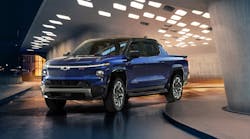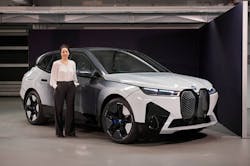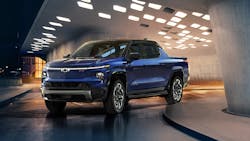CES 2022: A Peek at the EV Future
Check out our CES 2022 coverage.
What you'll learn:
- BMW's color-changing car body with the touch of a button.
- GM's Chevy Silverado EV and its adoption of Qualcomm's Snapdragon Ride Platform.
- Sony's new VISION S SUV using the EV/cloud platform.
Whether you were able to attend in-person or digitally, CES 2022 was, if nothing else, a great auto show—one that brought back memories of going with your family as a kid to see the “cars of the future.” Only now as stuffy business-oriented adults we refer to these dream machines as “the mobility experience of tomorrow.”
Changing Body Color on a Whim
Want a for-instance? Okay, how about a car whose exterior color can be adapted to different situations and individual wishes at the touch of a button. The surface of the BMW iX Flow featuring E Ink includes a specially developed body wrap stimulated by electrical signals to change the color of the vehicle's exterior at the driver's prompting. It can go from white to gray or black and back again in moments. Said Frank Weber, a member of BMW AG's board of management: "With the BMW iX Flow, we are bringing the car body to life."
Due to the pandemic situation, the BMW Group moved all planned media activities at CES to a fully digital program livestreamed from Germany. So, CES served as a virtual platform for the world premiere of iX Flow and the new BMW iX M60 EV, which has a combined electricity consumption of 24.7 to 21.7 kWh/100 km based on Europe’s WLTP measurement.
The most powerful and fastest electric vehicle in BMW’s product portfolio, the iXM60 has a joint system output of 455 kW/619 PS from two electric motors, a maximum torque of 1,015 Nm in Sport mode, or 1,100 Nm when Launch Control is active. With its electric all-wheel drive and its M specific chassis tuning, the BMW iX M60 sprints from a standing start to 100 km/h in just 3.8 seconds.
BMW also introduced a new addition to its My Modes feature. In combination with the in-car “entertainment system of the future” in My Mode Theatre, the rear of the interior transforms into a private cinema lounge, incorporating the BMW Theatre Screen, a 31-in. ultra-wide display in 32:9 format, surround sound, and 5G connectivity. There, passengers in the rear seats can enjoy a cinema experience with an entertainment program that can be selected individually on a display with a resolution of up to 8K.
Commented Frank Weber, “We develop immersive, digital experiences for sheer driving pleasure. In Theatre Mode, the rear of the interior is transformed into a private cinema lounge. With the 31 inch display, 5G connectivity, 8k resolution, surround sound and individual streaming programs an unprecedented experience is created that sets new standards in in-car entertainment."
Chevy Silverado EV and Snapdragon
Headlining GM’s CES entries is the 2024 Chevrolet Silverado full-size pickup EV. At launch, the Silverado EV will be available in two configurations: an RST First Edition and a fleet-oriented WT model. The Silverado EV will offer a GM-estimated 400-mile range on a full charge along with 10.2 kW of offboard power, available four-wheel steering, a fixed-glass roof, and a 17-in.-diagonal LCD infotainment screen.
GM’s plans for the EV market in the U.S. beyond the Chevrolet Silverado EV will include a Chevrolet Equinox EV SUV with an estimated MSRP starting around $30,000, as well as a larger Chevrolet Blazer EV SUV. Both the Equinox EV and Blazer EV will be available in 2023.
GM will be the first company to use Qualcomm Technologies’ Snapdragon Ride Platform for advanced driver-assistance technology. The new compute architecture will have the processing capability of several hundred personal computers, but is only about the size of two laptops placed on top of one another.
At CES, Qualcomm Technologies introduced the latest addition to the Snapdragon Ride Platform portfolio—the Snapdragon Ride Vision System. The open, scalable, and modular computer-vision software stack is built on a 4-nm process technology system-on-chip (SoC) designed for an optimized implementation of front and surround cameras for advanced driver-assistance systems (ADAS) and automated driving (AD).
Combining the Snapdragon Ride SoCs with the next-generation vision perception software stack from Arriver, the Snapdragon Ride Vision System supports the various compute functions needed for enhanced perception around the vehicle. This allows for planning and acting to create a safer driving experience.
The Vision Perception, which was created earlier in 2021 by Arriver’s parent company Veoneer, combines human perception and AI. For example, for a car to automatically map the environment around it and provide those insights to trigger automated responses, such as braking or warnings to drivers, sensors must be able to accurately capture that data and integrate it with systems inside the vehicle. The sensors also must connect it wirelessly to augment, process, and apply it in real-time.
Arriver developed the necessary software stack, ranging from perception algorithms to support for automated-driving features. When incorporated with Qualcomm Technologies’ Snapdragon Ride platform, it yields a fully functioning solution. The collaboration is poised to deliver not just next-gen technology, but a solution that’s road-tested and ready for production starting in 2024.
VISION-S Part Deux
Two years ago, at CES 2020, Sony’s "VISION-S" was an initiative aimed at contributing to the evolution of mobility via a prototype vehicle at its booth. Sony started public road testing in Europe in December of the same year and began verification tests of the safety and user experience of the imaging and sensing technology installed inside and outside the vehicle.
By showing a new SUV-type prototype vehicle (VISION-S 02) at CES 2022, Sony is utilizing the large interior space and variations of a 7-seater. This vehicle uses the same EV/cloud platform as the prototype (VISION-S 01), which is being tested on public roads.
The system supports safe driving by recognizing and analyzing the surrounding environment in real-time, with sensors installed 360 degrees around the vehicle. These sensors include high-sensitivity, high-resolution, wide-dynamic-range CMOS image sensors and LiDAR sensors that accurately sense three-dimensional space.
In addition, the system provides intuitive driver interaction in conjunction with the vehicle's sound system and HMI system. Thus, the driver can accurately judge the status of the surrounding environment, such as the presence of emergency vehicles, even from inside the vehicle. Sony is currently conducting functional verification tests in Europe toward the release of Level 2+ ADAS on public roads.
In the Vision-S 02, key locks and other user settings can be synchronized by linking the vehicle to the cloud using mobile communication, including 5G, which features low-latency, high-capacity, and high-speed capabilities. In addition, since updates are reflected in the vehicle via over the air (OTA), it’s possible to provide security and evolve service functions and value-added offerings.



